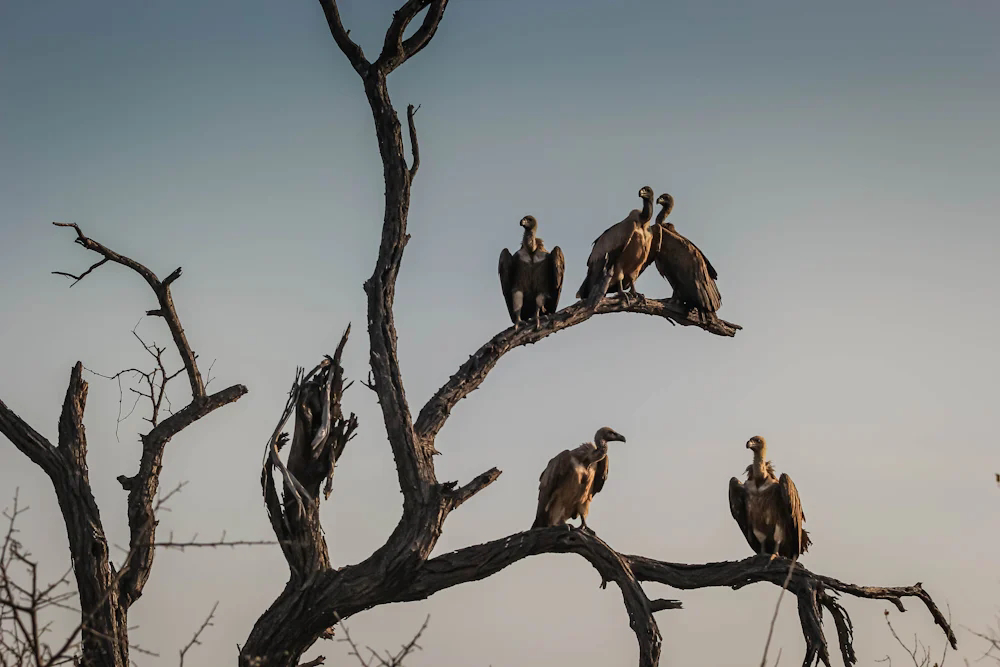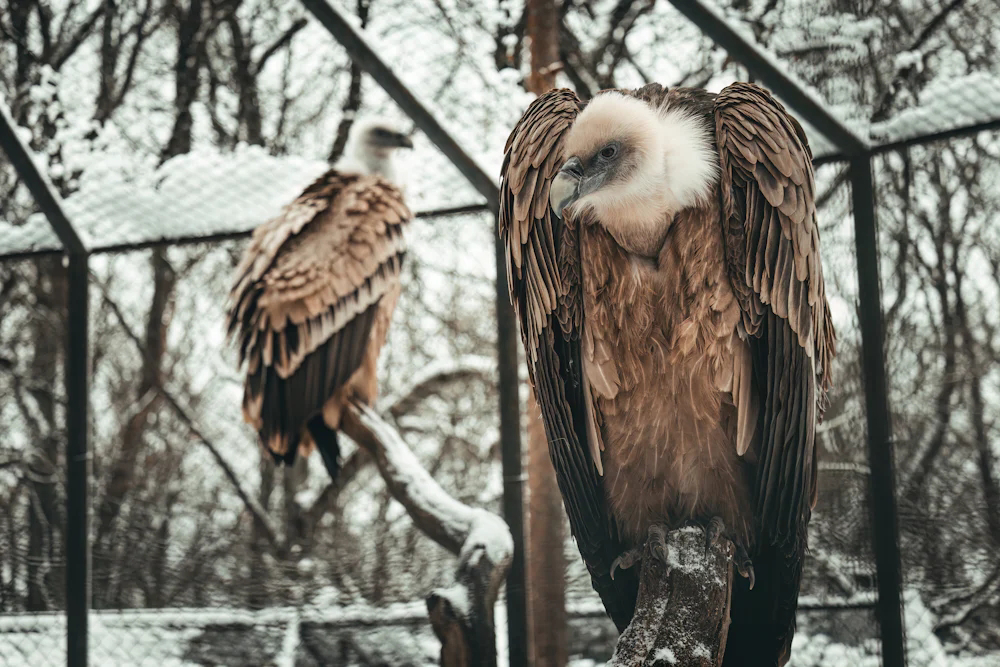Vultures are among the most misunderstood yet essential creatures in the animal kingdom. Often viewed as symbols of death and decay, they play a critical role in the ecosystem by cleaning up carcasses and preventing the spread of disease. Here are 18 mysterious facts about vultures that showcase their unique abilities and importance.
1. NATURE'S CLEANUP CREW
Vultures are scavengers, feeding primarily on the carcasses of dead animals. This behavior helps to keep ecosystems clean by preventing the buildup of decomposing bodies that could spread diseases.
2. THEY SOAR FOR HOURS WITHOUT FLAPPING
Many species of vultures are capable of soaring to incredible heights—up to 10,000 feet. They use thermal updrafts to glide effortlessly across the sky in search of food without expending much energy.
3. DISTINCTIVE BALD HEADS
Vultures are often depicted with bald heads, a feature that helps them stay clean while feeding on carcasses. A featherless head prevents feathers from becoming soiled with blood and bacteria.
4. EFFICIENT DIGESTIVE SYSTEMS
Vultures possess highly acidic stomachs capable of breaking down putrid meat, bones, and even toxins found in rotting flesh. This strong stomach acid also helps to kill harmful bacteria like anthrax and botulism.
5. SCAVENGER WITH A PURPOSE
Despite their reputation for eating dead animals, vultures play a vital role in preventing the spread of diseases. By consuming carcasses quickly, they eliminate pathogens that might otherwise infect the environment or other animals.
6. THEY WERE WORSHIPPED IN ANCIENT EGYPT
In ancient Egyptian mythology, vultures were seen as symbols of motherhood and protection. The goddess Nekhbet, often depicted as a vulture, was the protector of the pharaohs and the nation. Egyptians also believed vultures were all female and reproduced through the power of the wind—adding to their mystical reputation.
In ancient Egyptian mythology, vultures were seen as symbols of motherhood and protection. The goddess Nekhbet, often depicted as a vulture, was the protector of the pharaohs and the nation. Egyptians also believed vultures were all female and reproduced through the power of the wind—adding to their mystical reputation.
In some cultures, vultures are seen as symbols of renewal and purification. They are respected for their role in cleaning up the environment and are sometimes associated with death and rebirth in spiritual practices.
7. BEARDED VULTURES EAT BONES AND NOTHING ELSE
The bearded vulture (lammergeier) is one of the most unique vulture species. Unlike other vultures that prefer soft tissue, bearded vultures eat mostly bones, making up 85–90% of their diet. They have powerful stomach acid that dissolves bones, allowing them to extract the nutritious marrow. To break large bones into smaller pieces, they drop them from great heights onto rocks—a behavior rarely seen in other birds.
8. VULTURES AND SOCIAL FEEDING
Some vultures feed in large groups, known as a "wake." These feeding groups can involve dozens of vultures, sometimes even hundreds, that come together when a large carcass is found.
9. UNIQUE COMMUNICATION
Vultures communicate with each other through a variety of vocalizations, including grunts, hisses, and clicks. They also use body language, such as wing flapping and head movements, to signal to others.
10. VULTURES CAN DETECT DEATH FROM MILES AWAY
Certain vultures, like turkey vultures, have an incredible sense of smell, capable of detecting the gases released by decaying flesh from over a mile away. This ability helps them locate food before other scavengers.
11. THEY VOMIT AS A DEFENSE MECHANISM
If threatened, a vulture may projectile vomit its last meal to deter predators. This not only creates a disgusting distraction but also makes the bird lighter, allowing for a quick escape.
12. SOME VULTURES HUNT LIVE PREY
While most vultures strictly scavenge, some species, like the bearded vulture (lammergeier), are known to drop bones from great heights to crack them open and eat the marrow inside. Others, like the palm-nut vulture, eat plant-based foods as well.
13. THEY PLAY AN IMPORTANT ROLE IN DISEASE CONTROL
By consuming rotting carcasses, vultures prevent the spread of deadly diseases like rabies and tuberculosis. In places where vulture populations have declined, disease outbreaks in animals and humans have increased.
14. THEY HAVE AN UNUSUAL SOCIAL HIERARCHY
When multiple vultures gather at a carcass, they follow a strict pecking order. Larger species like Andean condors and lappet-faced vultures eat first, while smaller vultures wait their turn. This system prevents unnecessary fights.
15. A DIVERSE GROUP
There are around 23 species of vultures worldwide, divided into two main groups: Old World vultures (found in Africa, Asia, and Europe) and New World vultures (found in the Americas). Although both groups are scavengers, they are not closely related and evolved separately.
16. SOME VULTURES URINATE ON THEMSELVES FOR HYGIENE
Some vultures practice urohidrosis, which means they urinate on their own legs. This behavior serves two main purposes:
1. Cooling Down—In hot environments, urination helps vultures regulate their body temperature. As the liquid evaporates from their legs, it provides a cooling effect, similar to how sweating works in humans.
2. Killing Bacteria—Since vultures often walk on carcasses while feeding, their legs can get covered in harmful bacteria and blood. Their urine is highly acidic, which helps disinfect their legs and prevent infections.
Turkey vultures and other New World vultures are especially known for this strange but effective adaptation.
17. THE ANDEAN CONDOR IS ONE THE LARGEST FLYING BIRDS IN THE WORLD
The Andean condor, a member of the vulture family, is one of the largest flying birds in the world. With a wingspan of up to 10.5 feet (3.2 meters) and a weight of around 30 pounds (13.6 kg), it dominates the skies of South America.
18. VULTURES' ROLE IN AGRICULTURE
By consuming carcasses, vultures help prevent the spread of diseases that could affect livestock. This is particularly important in rural and agricultural areas, where diseases like foot-and-mouth or mad cow disease can be devastating.
---
Vultures are far more than mere scavengers—they are indispensable to maintaining a healthy ecosystem. Their unique adaptations and behaviors make them fascinating creatures that deserve more recognition and protection. By understanding their ecological importance, we can better appreciate these remarkable birds and the critical role they play in nature’s balance.









0 Comments